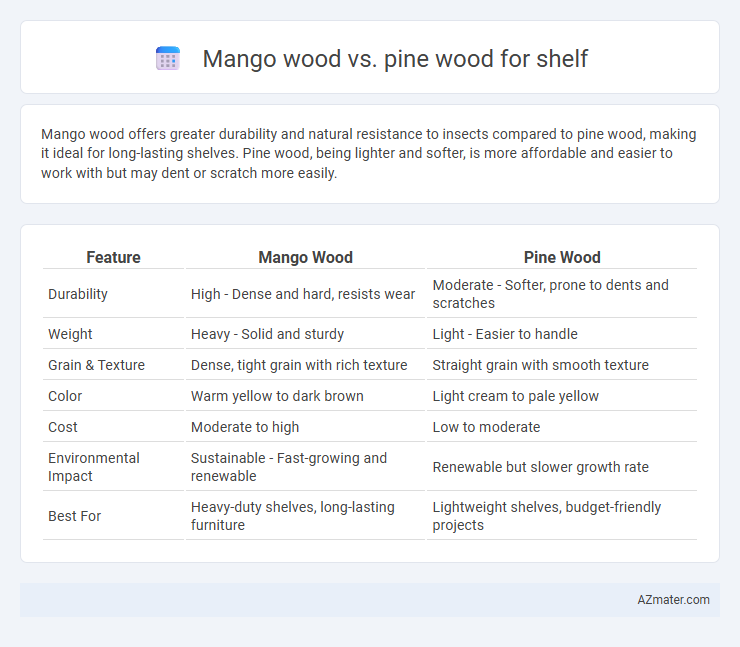Mango wood offers greater durability and natural resistance to insects compared to pine wood, making it ideal for long-lasting shelves. Pine wood, being lighter and softer, is more affordable and easier to work with but may dent or scratch more easily.
Table of Comparison
| Feature | Mango Wood | Pine Wood |
|---|---|---|
| Durability | High - Dense and hard, resists wear | Moderate - Softer, prone to dents and scratches |
| Weight | Heavy - Solid and sturdy | Light - Easier to handle |
| Grain & Texture | Dense, tight grain with rich texture | Straight grain with smooth texture |
| Color | Warm yellow to dark brown | Light cream to pale yellow |
| Cost | Moderate to high | Low to moderate |
| Environmental Impact | Sustainable - Fast-growing and renewable | Renewable but slower growth rate |
| Best For | Heavy-duty shelves, long-lasting furniture | Lightweight shelves, budget-friendly projects |
Introduction: Mango Wood vs Pine Wood for Shelving
Mango wood offers exceptional durability and rich grain patterns ideal for high-quality shelving, while pine wood is lightweight with a softer texture, making it easier to work with but less resistant to wear. Mango wood's natural hardness provides superior load-bearing capacity and resistance to dents compared to pine, which may dent or scratch more easily. Pine shelves are more affordable and readily available, but mango wood's unique aesthetic and robustness make it a preferred choice for long-lasting, decorative shelving units.
Physical Properties: Strength and Durability
Mango wood exhibits higher density and hardness compared to pine wood, resulting in superior strength and resistance to dents and scratches for shelving applications. Pine wood, being softer and more porous, is prone to dents and wear but offers lighter weight and easier workability. The natural oils in mango wood enhance its durability and resistance to moisture, making it more suitable for long-lasting shelves in varied environments.
Appearance and Aesthetic Comparison
Mango wood features a rich, warm color range from light brown to golden yellow with unique grain patterns that add a natural rustic charm to shelves. Pine wood tends to have a lighter, creamy hue with more uniform grain, offering a clean and classic look but less variation in texture. The distinct, vibrant grain and durability of mango wood make it a preferred choice for creating visually striking, sturdy shelves compared to the softer, more subtle aesthetic of pine wood.
Weight and Ease of Handling
Mango wood is denser and heavier than pine wood, providing more durability and strength for shelving applications but making it less easy to handle during installation. Pine wood, being lighter and softer, is easier to cut, shape, and install, making it a more user-friendly choice for DIY shelves. The weight difference impacts transportation and mounting, with pine offering greater versatility in ease of handling while mango wood offers superior robustness.
Workability: Cutting, Shaping, and Finishing
Mango wood offers excellent workability with smooth cutting and carving due to its medium hardness and fine grain, making it ideal for detailed shelf designs. Pine wood is softer and easier to shape, but its resin content can cause challenges in sanding and finishing, sometimes requiring additional sealing. Both woods accept stains and finishes well, though mango wood provides a more consistent and polished end result.
Sustainability and Environmental Impact
Mango wood is a sustainable choice for shelves due to its origin from fruit-bearing trees that are harvested after fruit production declines, reducing waste and deforestation. Pine wood, while fast-growing and renewable, often comes from plantation forests that may rely on intensive farming practices affecting biodiversity. Choosing mango wood supports eco-friendly furniture by utilizing a byproduct of agriculture, whereas pine requires careful sourcing to ensure minimal environmental impact.
Price Comparison: Mango vs Pine
Mango wood shelves generally cost more than pine wood shelves due to their higher density and durability, making them a premium choice for long-lasting furniture. Pine wood is more affordable and widely available, appealing to budget-conscious buyers seeking lightweight and easy-to-work wood. Price differences typically range from 20% to 40%, with mango wood commanding higher prices because of its rich grain and resistance to wear.
Maintenance and Longevity
Mango wood shelves require minimal maintenance due to their natural durability and resistance to decay, making them ideal for long-term use in humid environments. Pine wood, while affordable and lightweight, is more prone to scratches and dents, necessitating regular sealing or varnishing to prolong shelf life. Proper treatment and maintenance can extend the longevity of pine shelves, but mango wood inherently offers superior strength and resistance to wear over time.
Best Uses: Which Wood Suits Your Shelf Needs?
Mango wood offers exceptional durability and resistance to wear, making it ideal for heavy-duty shelves meant to hold substantial weight or decorative items. Pine wood is lightweight and easy to work with, suitable for budget-friendly shelves designed for light to moderate storage or decorative purposes. Choosing between mango and pine wood depends on whether you prioritize strength and longevity or affordability and ease of customization for your shelf needs.
Final Verdict: Choosing the Right Wood for Your Shelf
Mango wood offers superior durability, rich grain patterns, and natural resistance to wear, making it ideal for sturdy, long-lasting shelves with a unique aesthetic. Pine wood, while more affordable and lightweight, tends to be softer and prone to dents, requiring regular maintenance to preserve its appearance. For a balance of strength and visual appeal in high-use areas, mango wood is the better choice, whereas pine suits budget-conscious projects with lighter use.

Infographic: Mango wood vs Pine wood for Shelf
 azmater.com
azmater.com